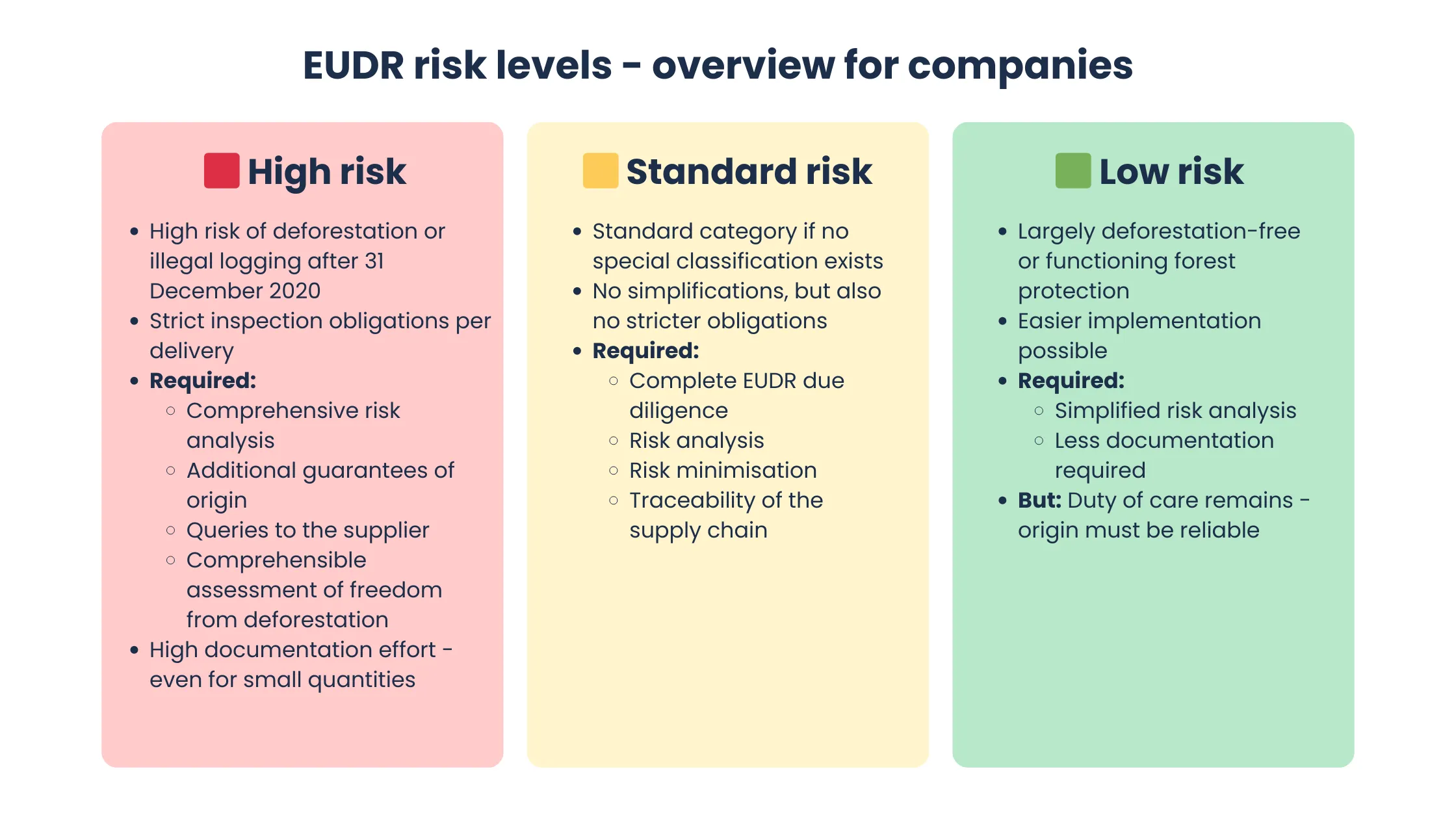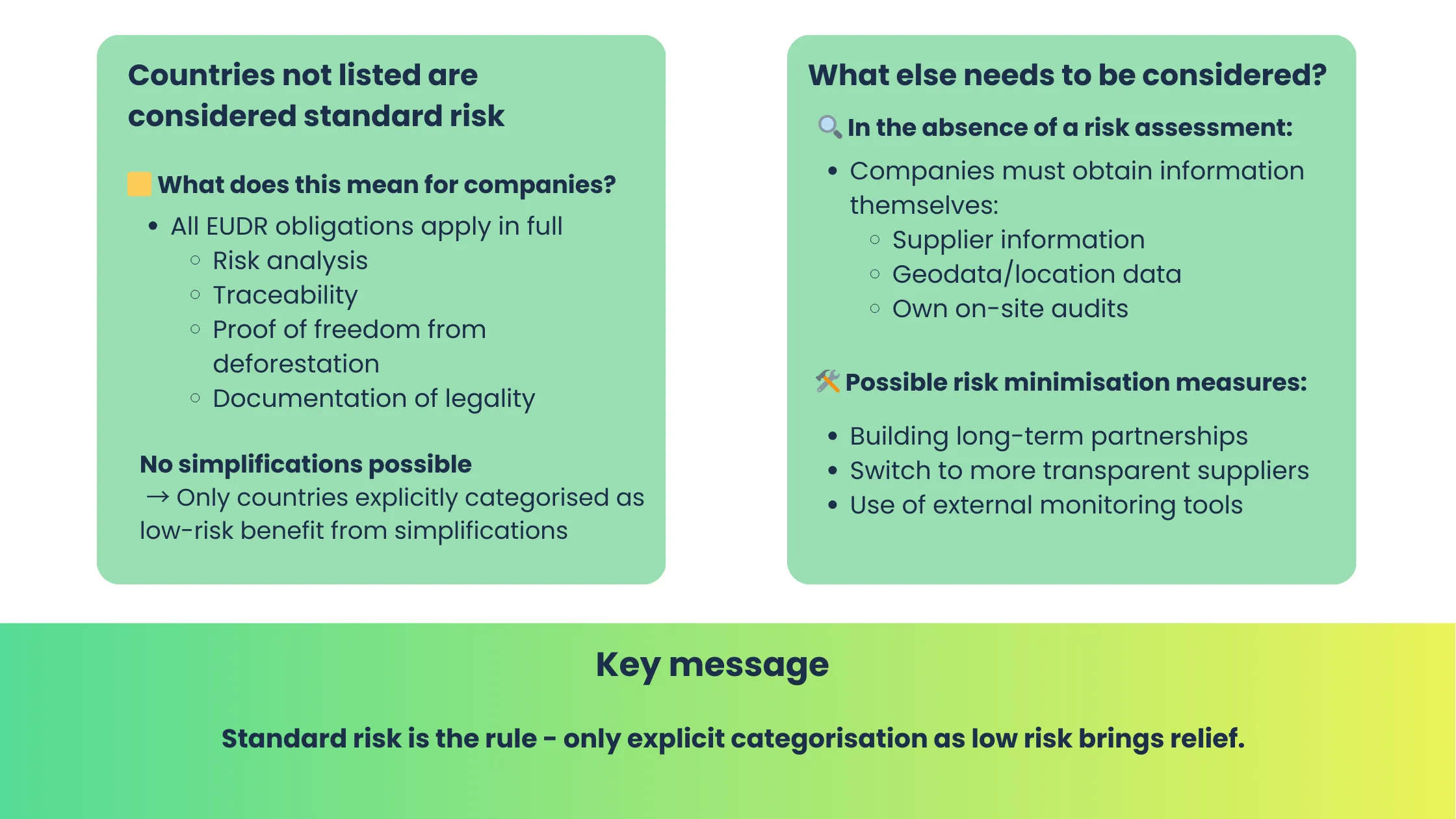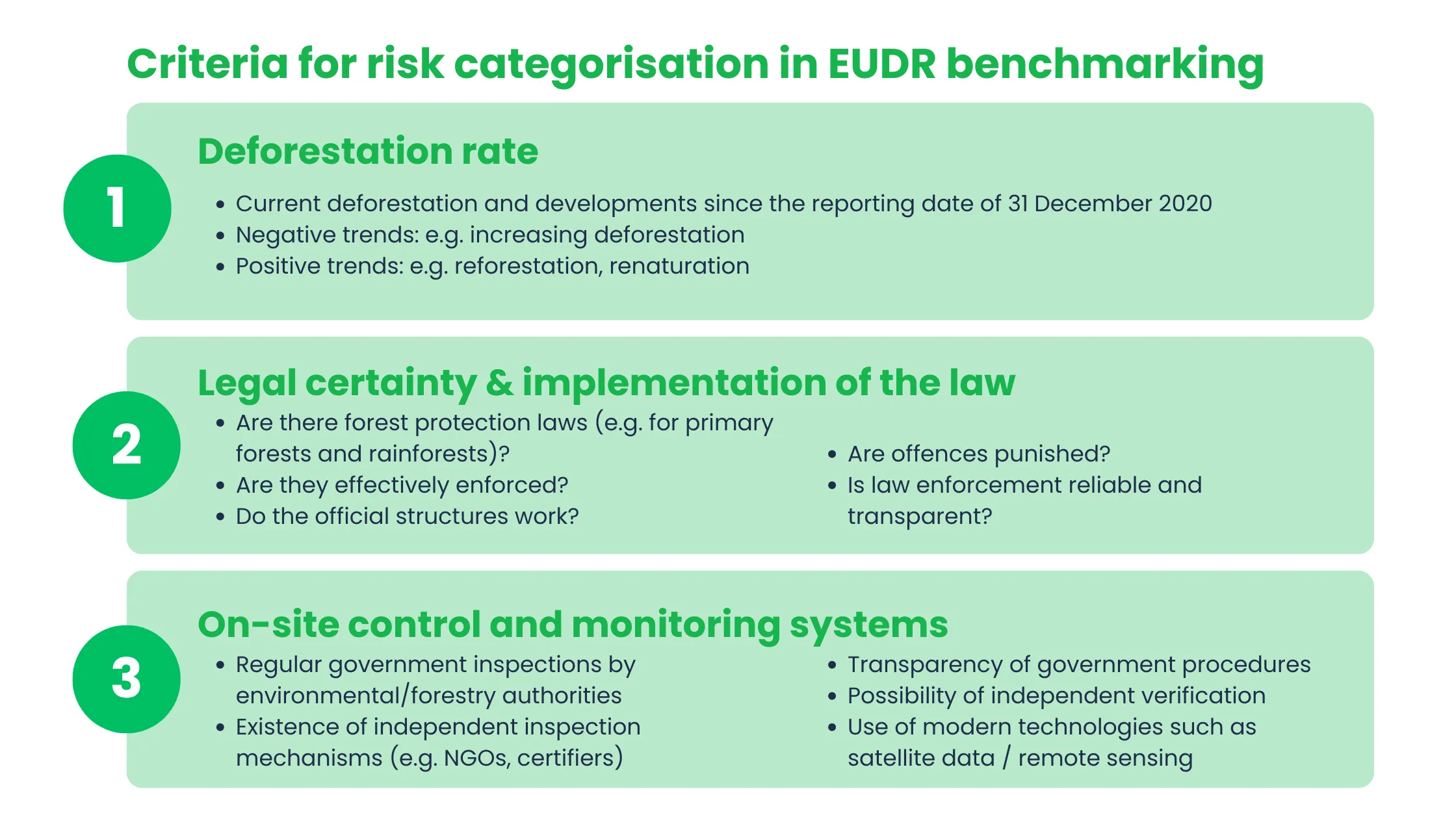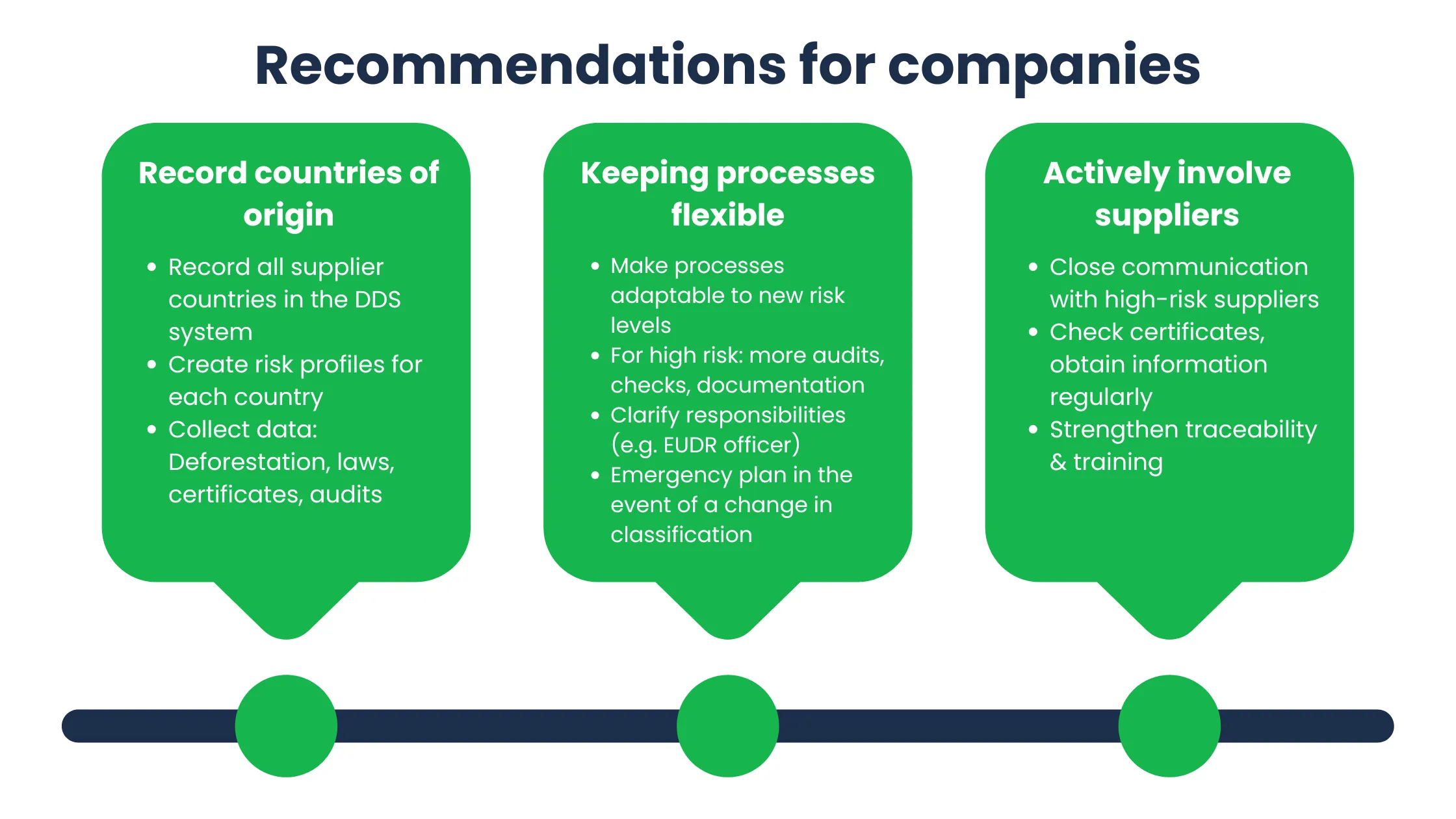EUDR country benchmarking: How the EU will assess risk in countries of origin in future - and what this means for companies
EUDR - Reading time: 9 Min
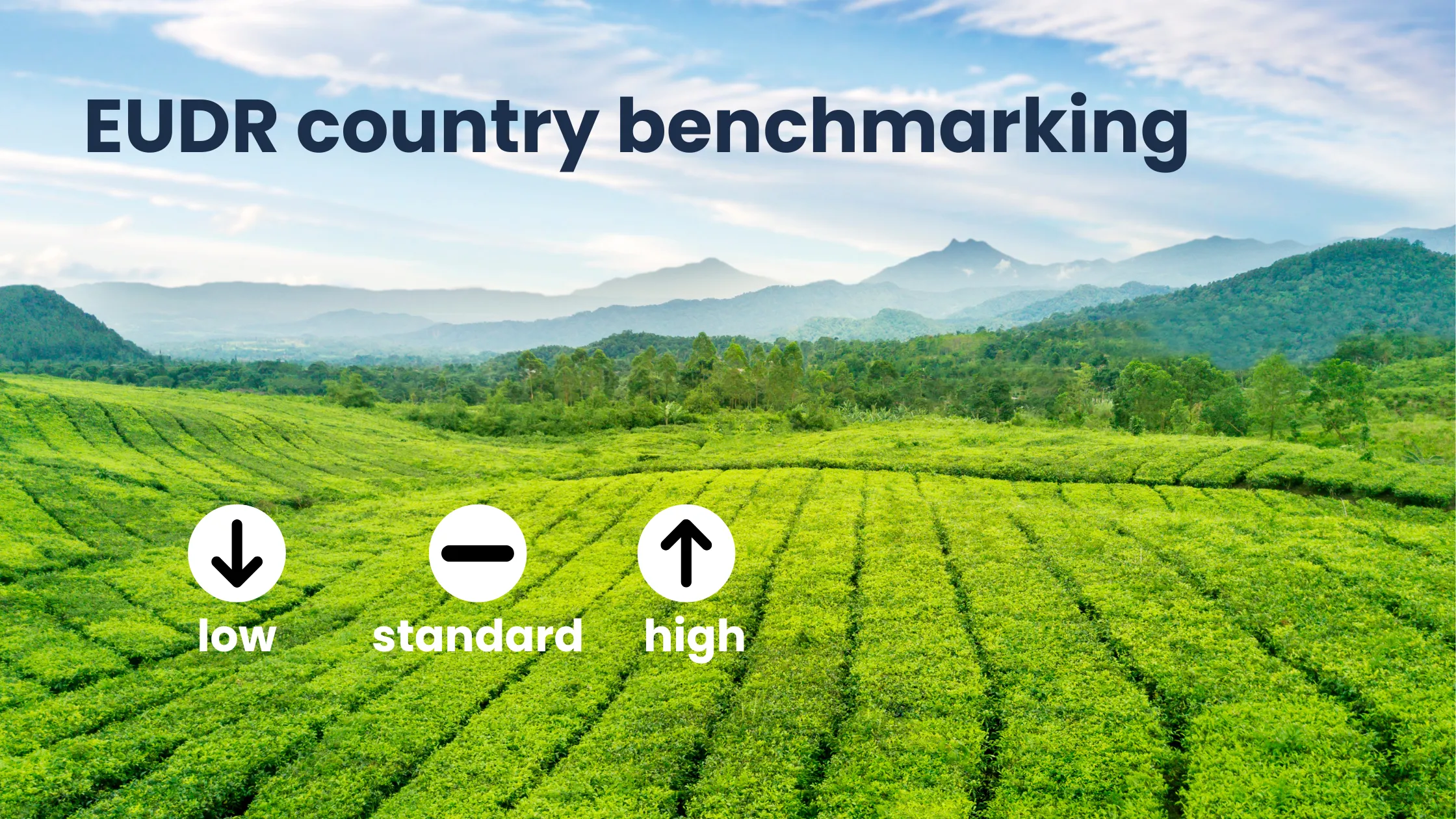
With the EU Regulation against Deforestation (EUDR), the European Union is tightening the requirements for companies that import or trade in deforestation-relevant raw materials such as soy, coffee, palm oil, cocoa, beef, wood or rubber. A key instrument is the planned country benchmarking system: in future, it will classify countries of origin according to their deforestation risk and thus help companies to implement their due diligence obligations on a risk-based basis. Although the system is still under development, it is already clear that the future classification will have a concrete impact on due diligence processes. This article explains how benchmarking works, what criteria the EU is applying and how companies can make strategic preparations today.
The most important facts at a glance
To enable companies to implement their due diligence obligations on a risk-based basis and to focus monitoring on high-risk areas.
They must provide more comprehensive checks, evidence and documentation - regardless of the quantity of raw materials traded.
No, although it simplifies the obligations, it does not release you from the responsibility for risk assessment and documentation.
It is automatically considered a standard risk country, which means that all due diligence obligations are applied in full.
Executive Summary
With the EU Commission's country benchmarking system, the implementation of the Regulation on deforestation-free supply chains (EUDR) is taking shape. For the first time, countries of origin of raw materials such as soy, coffee, cocoa, palm oil, wood, beef and rubber are officially categorized into three risk levels: low, standard and high. This classification has a direct impact on companies, as it determines how comprehensively due diligence obligations must be fulfilled, particularly in terms of risk analysis, documentation and traceability. While significantly stricter inspection obligations apply to deliveries from high-risk countries, the classification as low-risk allows for simplified implementation - without completely eliminating responsibility. Benchmarking should be regularly reviewed and adapted so that companies must keep their supply chains and compliance processes up to date. Those who start now to systematically record countries of origin, design internal processes flexibly and integrate suppliers in risk regions more closely will gain an important head start in EUDR implementation. The article explains how the benchmarking system works, the differences between the risk levels and provides specific recommendations for operational practice.
What is the EUDR benchmarking system?
Risk classification of countries of origin for raw materials
The benchmarking system of the EU Deforestation Regulation helps companies to better assess which countries pose an increased risk of deforestation or forest degradation. The EU not only takes into account direct deforestation, but also whether environmental and forest protection laws are complied with in the respective country. In May 2025, the EU Commission published an official list of countries for the first time. This classifies countries of origin into three risk categories: low risk, standard risk and high risk. The aim is to align companies' due diligence obligations on a risk basis - i.e. with greater effort where the risk is particularly high. This provides greater clarity for companies: anyone sourcing raw materials such as coffee, cocoa or wood from countries such as Brazil, Vietnam or the Ivory Coast can now view the respective classification directly and adjust their due diligence obligations accordingly. This means that resources can be used in a more targeted manner without completely eliminating the duty of care.
It remains important: Certain obligations must also be complied with for low-risk countries. However, the classification relieves companies in terms of the depth of risk analysis and documentation. The benchmarking system thus creates an important framework for greater legal certainty and efficiency in the implementation of and compliance with the EUDR.
Three risk levels: High, Standard, Low - what does this information mean in concrete terms?
The EU Commission's country benchmarking divides countries and territories of origin into three risk levels: high risk, standard risk and low risk. This classification has a direct impact on the extent to which companies must fulfill their due diligence obligations - for example in terms of risk analysis, data procurement and internal documentation.
- High risk:
Countries with the "high risk" label are considered particularly susceptible to deforestation or illegal logging. In these cases, the EU assumes that the relevant raw materials often come from areas that were deforested or degraded after the cut-off date of December 31, 2020. This contradicts the objectives of the regulation. For companies, this means that every delivery from a high-risk area must be examined particularly closely. This includes, for example, a comprehensive risk analysis, additional proof of origin, queries to the supplier if necessary and a clearly comprehensible assessment of the absence of deforestation. The documentation effort is significantly higher - even for smaller quantities. - Standard risk:
The "Standard" risk level is the basic category for all countries that have not yet been assessed differently by the EU Commission. It applies even if there is not yet enough information for a precise classification. For companies, this means that they must fully comply with all the usual EUDR obligations for deliveries from such countries - i.e. carry out a risk analysis, take risk mitigation measures and ensure traceability. There are no simplifications, but there are also no additional obligations as in the case of high-risk countries. - Low risk:
Countries or regions with "low risk" status are considered by the EU Commission to be either largely deforestation-free or have effective laws and a functioning system to protect their forests. For importers, this means that certain parts of the due diligence obligation can be simplified or implemented more efficiently - for example through simplified risk analyses or less documentation effort. For market participants, this means that a simplified due diligence obligation applies to sourcing from low-risk countries (Art. 13 para. 1 EUDR). This means that market participants and traders should collect information, but do not have to carry out risk analyses or take measures to mitigate risks. Please note: This simplification does not apply if there is a risk of mixing with products of unknown origin or from countries with a high or normal risk.
Important: Even for countries with "low risk" status, the EUDR still applies and companies are not automatically exempt from their obligations. They must ensure that their deliveries really do come from uncritical regions. Even in low-risk countries, there can be differences, for example between well-monitored export areas and less controlled regions. Therefore, an appropriate risk assessment based on the available information remains mandatory. The aim of the system is to make more targeted use of resources: Less bureaucracy for clearly unproblematic supply chains, but more control where the risk is high. In this way, the EU wants to prevent problematic imports from slipping through and is ensuring clear but adaptable rules with the three risk levels.
Where is the benchmarking published? The role of the EU Commission
Responsibility for the country benchmarking system lies with the European Commission. Under Article 29 of the EUDR, the Commission is obliged to draw up and regularly update a public list classifying countries or regions of origin according to their deforestation risk. The first version of this classification was published on May 30, 2025 and is available on the official EUDR website of the EU Commission. The list is reviewed regularly and can be adjusted in the event of changes to the framework conditions, for example in the event of increasing deforestation, changes to legislation in countries of origin or new scientific findings. A re-evaluation is planned at least every two years.
For companies, this means that if the risk classification of a country changes, they must adjust their due diligence obligations accordingly. If a country that was previously considered a low risk is classified higher in the future, the effort required for audits and documentation will increase. Companies should therefore keep a regular eye on the benchmarking system and structure their internal processes flexibly. The EU Commission evaluates countries according to clear, comprehensible criteria - for example, the deforestation rate, the implementation of environmental laws, the work of local authorities and cooperation with international partners on forest protection. Feedback from discussions with EU states, countries of origin and civil society organizations is also incorporated into the assessments.
What impact does risk classification have on companies?
Influence on the due diligence obligations
The benchmarking system is more than just a country classification, as it becomes the central management tool for the practical implementation of due diligence obligations. The risk classification of a country of origin determines how thoroughly a company must analyze, document and monitor its supply chains. The EUDR does not differentiate between sectors, but is based on the risk associated with the geographical origin of a raw material. If a country is classified as "low risk" by the EU, companies can apply simplified due diligence obligations for these sources of supply. This means less extensive risk analysis and less documentation work. However, due diligence obligations cannot be dispensed with altogether. The situation is different for countries with normal or high risk: Here, the full due diligence obligation remains in place, including detailed risk analysis, due diligence declaration, risk mitigation measures and comprehensive verification documentation. In this way, benchmarking is intended to help focus efforts where they are most urgently needed and at the same time relieve the burden on companies whose products originate from regions with a demonstrably low risk of deforestation. This creates planning security, transparency and efficiency without lowering the level of protection for forests.
A practical example: A furniture manufacturer sources wood from both Finland and Indonesia. If Finland is classified by the EU as a low-risk country, the company can rely on a simplified testing procedure for this source of supply. For wood from Indonesia, on the other hand, the company must apply a full DDS. In this case, geodata, supplier declaration and, if necessary, risk mitigation measures are required.
Simplified requirements with low risk
If a country of origin is classified as "low-risk" by the EU, it will be easier for companies to implement their due diligence obligations under the EUDR - but these obligations will not be completely eliminated. This means that companies must also carry out a risk assessment for deliveries from low-risk countries, document this and submit it to the authorities if required. The difference is that the assessment can be based more on existing sources, such as government inspections, publicly accessible data or recognized certificates. A detailed case-by-case review of each individual delivery is not necessary as long as the overall risk assessment is conclusive, well-founded and kept up to date.
For example, a company imports palm oil from a country that has been classified as low-risk by the EU. In this case, it may be sufficient to use the national traceability data of the country of origin. The only prerequisite for this is that it is reliable and based on sectoral control systems. Own field inspections, satellite monitoring or additional audits can then be omitted if the overall risk is actually low and the sources of information used are reliable.
Companies must continue to be able to substantiate their risk assessment with concrete information. Even in the case of low-risk countries, they should regularly check whether political, economic or environmental conditions have changed. Anyone relying on a simplified audit today must ensure that they keep a constant eye on their supply chains. This can be done, for example, through automatic updates from benchmarking databases or a fixed review cycle in the compliance system. In practice, the focus is therefore shifting from individual case audits at product level to robust system audits at country level. This enables efficient processes - provided that companies are structurally in a position to take on this responsibility.
Not listed means standard risk
If a country of origin or region is not explicitly listed in the benchmarking system, it is automatically classified as a standard risk. For companies, this means that all due diligence obligations of the EUDR must be met in full and no relaxations apply here, including risk assessments. In addition, the entire supply chain must continue to be fully documented and the deforestation-free and legality of the products must be actively verified. This will be particularly challenging for imports from countries for which no clear risk assessment has yet been carried out. In such cases, companies are forced to obtain more in-depth information themselves, for example through additional supplier information, location data or on-site audits. Proactive measures such as establishing long-term partnerships, switching to better documented sources of supply or using external monitoring tools may also be necessary - depending on the risk situation. The decisive factor is therefore: standard risk is the normal case - not an exception. Only those who have been expressly classified as low risk by the EU can count on relief. All others should prepare themselves organizationally and procedurally for the full range of EUDR obligations.
How does the risk assessment work?
Deforestation rates, legal certainty, local control systems
The classification of countries or regions as part of the EUDR benchmarking system is based on a variety of criteria, which together are intended to provide as realistic a picture as possible of deforestation risks. A central element is the deforestation rate - both currently and in the years since the cut-off date of December 31, 2020. Negative trends such as ongoing deforestation or an increase in deforestation are particularly relevant here. The Global Forest Resource Assessments (FRA) developed by the Food and Agriculture Organization of the United Nations (FAO) was used as the data source for the deforestation rate in accordance with Article 29(3)(a), as this is the most important internationally recognized source. The first review of the country classification is scheduled for 2026 after the publication of the next Global Forest Resource Assessment.
However, positive developments, such as indications of reforestation or renaturation, are also taken into account. Another key indicator is legal certainty in the respective country. The decisive factor is not only whether there are laws to protect primary forests, rainforests or other forested ecosystems - but also whether these are applied effectively.
- Are there functioning official structures?
- Are violations punished?
- Is law enforcement reliable and comprehensible?
The EU also examines the quality of local government control and monitoring systems. This includes whether environmental or forestry authorities carry out regular inspections, whether there are independent inspection mechanisms (e.g. by NGOs or certifiers) and whether modern technologies such as satellite data are used. The transparency of government procedures and the possibility of independent verification are also included in the risk assessment. The FAOSTAT database is relevant for the other two criteria, the extent of the expansion of agricultural land for relevant commodities (Article 29(3)(b)) and the production trends for relevant commodities and relevant products (Article 29(3)(c)). It forms the basis for the assessment of these two criteria.
In summary, the benchmarking system goes far beyond the mere deforestation rate. It also looks at how reliably and credibly a country implements forest protection in practice - and how well companies can rely on official data and local controls.
Combination of remote sensing, reports and governance factors
The EU Commission also uses a range of state-of-the-art monitoring instruments. These include remote sensing data, which uses satellite images to detect and document changes in forest areas over long periods of time. This technical data is supplemented by on-site reports, assessments by expert commissions and international governance indicators. The relevant parameters include, for example, the Global Forest Watch Index, reports from the FAO (Food and Agriculture Organization of the United Nations) or findings from existing certification systems such as FSC or PEFC. Governance indicators such as Transparency International's Corruption Perceptions Index also play a role in identifying risks due to ineffective administration or corruption. EUDR benchmarking is therefore based on a multi-source model: quantitative measurements and qualitative assessments are combined so that there is no one-dimensional view of individual indicators. This methodology aims to provide the best possible objective picture of a country's or region's deforestation risk.
Participation of the member states and expert commission
The development of the EU benchmarking system is not a purely administrative task - it is the result of an exchange with many stakeholders from politics, business, science and civil society. The European Commission leads this process and is responsible for classifying the countries. It regularly coordinates with the EU member states, for example in committees, working groups or consultations. In this way, national experiences and assessments are also incorporated into the evaluation. In addition, the Commission obtains specific expertise, for example from environmental authorities, scientists, satellite data experts or lawyers who are familiar with forest and environmental laws. This ensures that the assessment is based on up-to-date knowledge - for example on the question of how forests are defined or how reliable remote sensing data is. External groups are also involved: NGOs, industry associations, companies and representatives of affected countries are allowed to contribute or comment. This open and broad-based dialog ensures greater transparency - and that the risk classifications meet with broad acceptance.
Recommendations for companies
Record and evaluate countries of origin in the DDS system at an early stage
Companies should adapt their supply chains to EUDR benchmarking at an early stage. It is important that they systematically record all countries and regions of origin of their raw materials and create a separate risk profile for each country. This should not only focus on countries with known deforestation problems - even seemingly uncritical regions can suddenly be upgraded. In order to be well prepared, companies should collect the most important information on each country of origin and store it centrally.
These include, for example:
- Current and past deforestation rates
- Applicable environmental and forestry laws
- Supplier certifications
- Results from our own tests and audits
This enables companies to react quickly in an emergency and demonstrate their duty of care.
Prepare internal processes for risk differentiation
Companies must be able to react quickly to new risk classifications under the EUDR. This means that internal processes should be organized in such a way that they can be adapted immediately if necessary, for example in terms of the frequency of supplier audits, the scope of documentation or the control measures used. Engagement in the countries of origin, for example through discussions with suppliers or additional on-site inspections, must also be stepped up if there is an increased risk. If a company sources raw materials from a country that is classified as a high-risk area by the EU, close monitoring and, if necessary, external audits are mandatory. In addition, there should be a contingency plan in case the risk classification of a country changes at short notice. It therefore makes sense to create clear internal responsibilities, for example through a special task force or an EUDR officer. This person or group should regularly review the current requirements of the EU Commission, initiate necessary measures and ensure that all compliance requirements are met.
Intensify supplier communication from high-risk countries
For companies that source many of their raw materials from countries with a high risk of deforestation, close cooperation with suppliers is particularly important. Only if information is clearly exchanged at an early stage can potential risks be identified and avoided in good time. This includes, for example, regular requests for relevant information, checking certificates and establishing long-term partnerships with trustworthy suppliers. The aim should be to make the entire supply chain as transparent as possible. Companies should not only inform their suppliers about the EUDR obligations, but also explain to them what this means in concrete terms for day-to-day practice. Certifications can help to create trust. In addition, digital traceability systems and joint training or inspection projects offer useful ways to reduce risk and jointly meet the requirements of the EUDR.
Conclusion and outlook
With the country benchmarking, the EU Commission offers companies an important tool for better assessing and managing supply chains. The classification into high, normal or low risk provides greater clarity and makes it clear how thoroughly companies need to check their raw materials. It is important to note that due diligence obligations remain in place even for low-risk countries. Companies must continue to ensure that their products have been produced legally and without deforestation. Those who prepare early, check countries of origin and adapt internal processes can save time and effort - and at the same time be on the safe side legally. Benchmarking is therefore not just a monitoring tool, but a real guide. It helps companies to address risks in a targeted manner, reduce bureaucracy and operate more sustainably. Those who act now are well positioned - for the EUDR and for responsible trade in the future.
FAQ
Country benchmarking is an evaluation system of the EU Commission that classifies countries of origin into three risk levels: low, standard and high. The aim is to support companies in implementing their due diligence obligations in accordance with EUDR. Depending on the classification, different strict requirements apply to risk analysis and documentation.
The benchmarking system should be reviewed and updated regularly, but at least every two years. In the event of significant changes in the deforestation situation or governance in certain regions, the classification can also be adjusted at short notice. Companies must therefore continuously adapt their supply chains and compliance processes to the current risk classifications.
Deliveries from low-risk countries are subject to simplified due diligence obligations - for example with regard to risk analysis and documentation. Nevertheless, the responsibility remains: Companies must check whether their products actually originate from non-critical regions and document this assessment with reasons.
Yes, the obligations of the EUDR also apply in the case of low risk - only in a weakened form. The risk analysis may be leaner, but it must not be omitted completely. Regional differences within a country must also be taken into account.
In this case, the standard risk status automatically applies. This means that companies must fully comply with all EUDR obligations - including comprehensive risk analysis, traceability and verification documentation.
Companies must regularly adapt their processes and actively monitor the risk classifications. If a country is upgraded, the requirements for testing and verification increase. Internal processes should therefore be flexible enough to be able to react quickly.
In this case, companies must ensure a clear geographical allocation for each delivery. If this cannot be proven beyond doubt, the risk classification for the higher risk must be assumed. Separation and traceability within the supply chain is therefore becoming increasingly important.
Certifications can be a useful indicator and proof of sustainable supply chains, but do not replace the relevant classification by the EU benchmarking system. They serve as supporting evidence for our own risk analyses, which must, however, always be compared with the official requirements.
The EUDR Benchmarking System will be mandatory for large companies from the date of application of the EUDR, i.e. from December 30, 2025. Small companies and SMEs will not be affected until June 30, 2026. It is therefore advisable to prepare internal processes and suppliers for the new requirements now.
